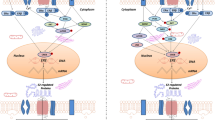Abstract
Dehydroepiandrosterone (DHEA) exerts multiple effects in the central nervous system. Most of them seem to be mediated through their nongenomic actions on neurotransmitter receptors, and these actions occur within seconds or milliseconds. DHEA increases neuronal excitability, enhances neuronal plasticity, and has neuroprotective properties. By investigating glutamate release from synaptosomes of rats at different ages (from 17 days to 12 months), we observed that (i) there is an increase in basal and K+-stimulated l-[3H] glutamate release in rats at 12 months old, when compared to other ages; and (ii) there is an inhibitory effect of DHEA on basal l-[3H] glutamate release in 12 months old. This inhibitory effect of DHEA could be related to its reported protective role against excitotoxicity caused by overstimulation of the glutamatergic system and ageing.
Similar content being viewed by others
references
Izquierdo, I. and Medina, J. H. 1997. Memory formation: The sequence of biochemical events in the hippocampus and its connection to activity in other brain structures. Neurobiol. Learn Mem. 68:285–316.
Ozawa, S., Kamiya, H., and Tsukuki, K. 1998. Glutamate receptors in the mammalian central nervous system. Prog. Neurobiol. 54:581–618.
Anderson, C. M. and Swanson, R. A. 2000. Astrocyte glutamate transport: Review of properties, regulation and physiological functions. Glia 32:1–14.
Robinson, M. B. and Dowd, L. A. 1997. Heterogeneity and functional subtypes of sodium-dependent glutamate transporters in the mammalian central nervous system. Adv. Pharmacol. 37:69–115.
Bole, D. G., Hirata, K., and Ueda, T. 2002. Prolonged depolarization of rat cerebral synaptosomes leads to an increase in vesicular glutamate content. Neurosci. Lett. 322:17–20.
Garcia-Sanz, A., Badia, A., and Clos, M. V. 2001. Superfusion of synaptosomes to study presynaptic mechanisms involved in neurotransmitter release from rat brain. Brain Res. Protoc. 7:94–102.
Baulieu, E. E. and Robel, P. 1998. Dehydroepiandrosterone (DHEA) and dehydroepiandrosterone sulfate (DHEAS) as neuroactive neurosteroids. Proc. Natl. Acad. Sci. 95:4089–4091.
Bergeron, R., Montigny, C., and Debonnel, G. 1996. Potentiation of neural NMDA response induced by dehidroepiandrosterone and its supression by progesterone: Effects mediated via sigma receptors. J. N. Eurosci. 16:1193–1202.
Rupprecht, R. and Holsboer, F. 1999. Neuroactive steroids: Mechanisms of action and neuropsychopharmacological perspectives. Trends Neurosci. 22:410–416.
Mellon, S. H. and Griffin, L. D. 2002. Neurosteroids: Biochemistry and clinical significance. Trends Endocrin. Metab. 13:35–44.
Kimonides, V. G., Khatibi, N. H., Svendesen, C. N., Sofroniew, M. V., and Herbert, J. 1998. Dehydroepiandrosterone (DHEA) and DHEA-sulfate (DHEAS) protect hippocampal neurons against excitatory amino acid-induced neurotoxicity. Proc. Natl. Acad. Sci. 95:1852–1857.
Sutherland, G. R., Gary, A. D., and Auer, R. N. 1996. Effect of age in rodent models of focal and forebrain ischemia. Stroke 27:1663–1667.
Dunkley, P. R., Heath, J. W., Harrison, S. M., Jarvie, P. E., Glenfield, P. J., and Rostas, J. A. 1998. A rapid Percoll gradient procedure for isolation of synaptosomes directly from an S1 fration: Homogeneity and morphology of subcellular fractions. Brain Res. 441:59–71.
Tavares, G. R., Tasca, I. C., Santos, S. E. C., Alves, B. L., Porciúncula, O. L., Emanuelli, T., and Souza, O. D. 2002. Quinilinic acid stimulates synaptosomal glutamate release and inhibits glutamate uptake into astrocytes. Neurochem. Int. 40:621–627.
Nagi, A. K., Shuster, T. A., and Delgado-Escueta, A. V. 1986. Ecto-ATPase of mammalian synaptosomes: Identification and enzymic characterization. J. Neurochem. 47:976–986.
Migues, V. P., Leal, B. R., Mantovani, M., Nicolau, M., and Gabilan, H. N. 1999. Synaptosomal glutamate release induced by the fraction Bc2 from the venom of the sea anemone Bunodosoma caissarum. Neuroreport 12:67–70.
Lowry, O. H., Rosebrough, N. J., Farr, A. L., and Randall, R. J. 1951. Protein measurement with the folin phenol reagent. J. Biol. Chem. 193:265–275.
Ozkan, E. D. and Udea, T. 1998. Glutamate transport and storage in synaptic vesicles. Jpn J. Pharmacol. 77:1–10.
Segovia, G., Porras, A., Del Arco, A., and Mora, F. 2001. Glutamatergic neurotransmission in aging: A critical perspective. Mech. Ageing Dev. 122:1–29.
Nicholls D. G. 1998. Presynaptic modulation of glutamate release. Prog. Brain Res. 116:15–22.
Racchi, M., Govoni, S., Solerte, S. B., Carrado I. G., and Corsini, E. 2001. Dehydroepiandrosterone and the relationship with aging and memory: A possible link with protein kinase C functional machinery. Brain Res. Rev. 1:287–293.
Haberny, K. A., Paule, M. G., Scallet, A. C., Sistare, F. D., Lester, D. S., Hanig, J. P., and Slikker, W. Jr. 2002. Ontogeny of the N-methyl-D-aspartate (NMDA) receptor system and susceptibily to neurotoxicity. Toxicol. Sci. 68:9–17.
Mellon, S. H., Griffin, L. D., and Campagnone N. A. 2001. Biosynthesis and action of neurosteroids. Brain Res. Rev. 37:3–12.
Ueda, H., Akira, Y., Shogo, T., Kinobu, M., Junko, M., Kiyoshi, M., et al. 2001. Neurosteroids stimulate G protein-coupled sigma receptors in mouse brain synaptic membrane. Neurosci. Res. 41:33–40.
Lambert, J. J., Beletti, D., Hill-Venning, C., and Peters, J. A. 1995. Neurosteroids and GABAA receptor function. Trends Pharmacol. Sci. 16:295–303.
Meyer D. A., Carta, M., Partridge D. L., Covey, D. F., and Valenzuela, C. F. 2002. Neurosteroids enhance spontaneous glutamate release in hippocampal neurons. J. Biol. Chem 277:28725–28732.
Cardounel, A., Regelson, W., and Kalimi, M. 1999. Dehydroepiandrosterone protects hippocampal neurons against neurotoxin-induced cell death: Mechanism of action. Proc. Soc. Exp. Biol. Med. 222:145–149.
Bastianetto, S., Ramassamy, C., Poirier, J., and Quirion, R. 1999. Dehydroepiandrosterone (DHEA) protects hippocampal cells from oxidative stress-induce damage. Mol. Brain. Res. 66:35–41.
Wolf, T. O. and Kirschbaum, C. 1999. Actions of dehydroepiandrosterone and its sulfate in the central nervous system: Effects on cognition and emotion in animals and humans. Brain Res. Rev. 30:264–288.
Kurata, K., Takebayashi, M., Kagaya, A., Morinobu, S., and Yamawaki, S. 2001. Effect of β-estradiol on voltage-gate Ca+ channels in rat hippocampal neurons: A comparison with dehydroepiandrosterone. Eur. J. Pharmacol. 416:203–212.
Massieu, L. and Tapia, R. 1997. Glutamate uptake impairment and neuronal damage in young and aged rats in vivo. J. Neurochem. 69:1151–60.
Author information
Authors and Affiliations
Corresponding author
Rights and permissions
About this article
Cite this article
Lhullier, F.L.R., Riera, N.G., Nicolaidis, R. et al. Effect of DHEA Glutamate Release from Synaptosomes of Rats at Different Ages. Neurochem Res 29, 335–339 (2004). https://doi.org/10.1023/B:NERE.0000013735.50736.0a
Issue Date:
DOI: https://doi.org/10.1023/B:NERE.0000013735.50736.0a




